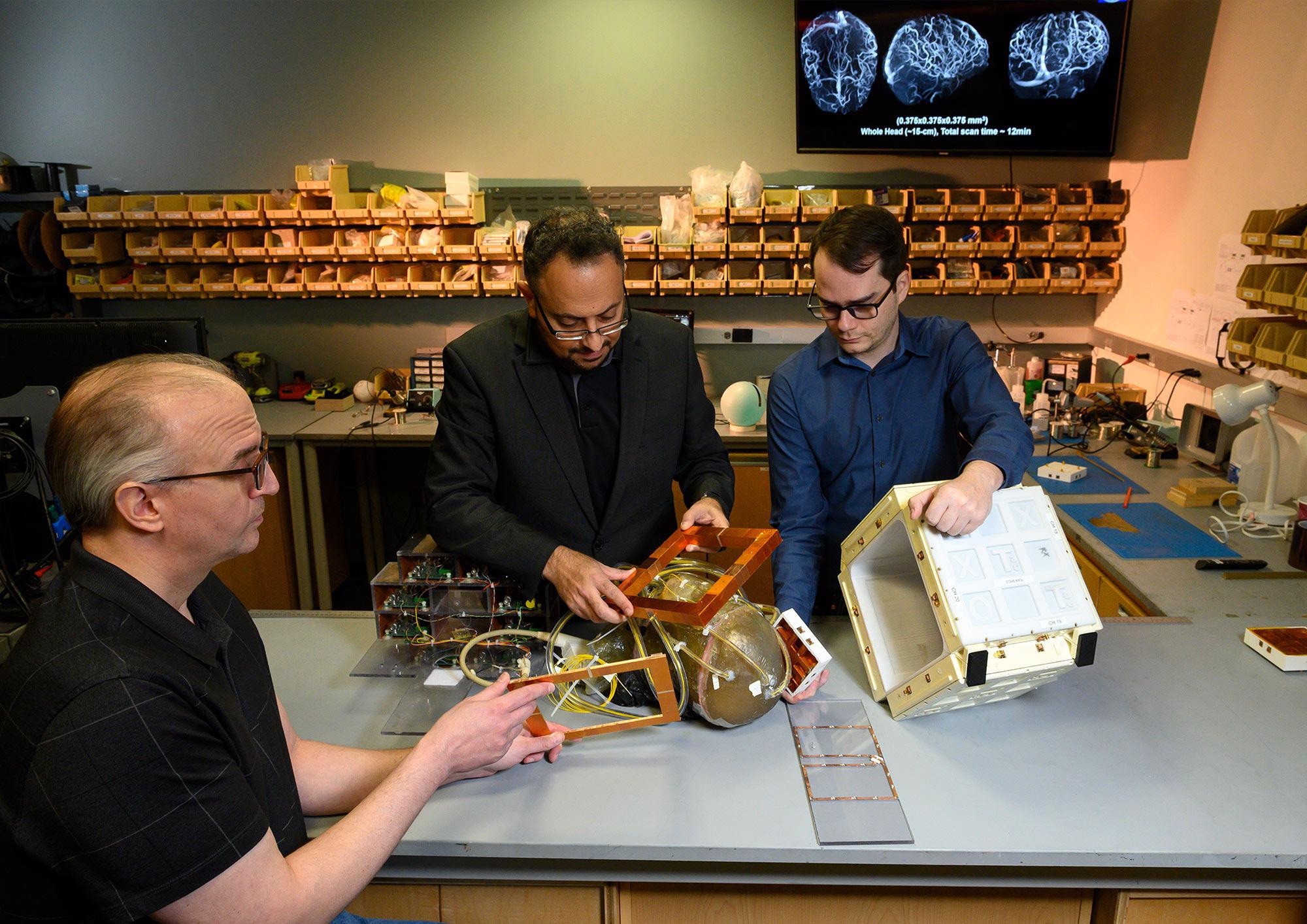Jun 4 2021
Sickle Cell Disease (SCD) is known to be a genetically inherited group of red blood cell disorders. The CDC has reported that around 90,000 to 100,000 individuals in the United States suffer from this disorder, and it disproportionately impacts Black or African Americans. SCD occurs in around 1 in every 500 people in this demographic.
 Dr Tamer Ibrahim (middle) and Dr. Tales Santini (right) in the Radiofrequency Research Facility at Pitt's Swanson School of Engineering. Santini holds the housing of the Tic-Tac-Toe coil system. Image Credit: University of Pittsburgh.
Dr Tamer Ibrahim (middle) and Dr. Tales Santini (right) in the Radiofrequency Research Facility at Pitt's Swanson School of Engineering. Santini holds the housing of the Tic-Tac-Toe coil system. Image Credit: University of Pittsburgh.
Scientists from the University of Pittsburgh Swanson School of Engineering have now used a special and robust MRI device to study the effect of this disease on the brain. The team has published their findings in the Neuroimage: Clinical journal.
They observed that SCD can have a major impact on particular subfields of the hippocampus—a highly complicated portion of the human brain that regulates memory and learning and is highly vulnerable to disorders or injury.
This is a first-of-its-kind project that uses our lab’s whole-body 7-Tesla magnetic resonance imager (7T MRI) alongside our optimized Tic Tac Toe RF head coil system to get clear and quality neural images of patients affected by SCD.
Tamer Ibrahim, Professor of Bioengineering and Director of Radiofrequency Research Facility and 7-Tesla Bioengineering Research Program, University of Pittsburgh
In SCD patients, their red blood cells contain abnormal hemoglobin levels. This can make the red blood cells sticky, hard, and mutate into a special crescent shape that suppresses the passage of the cell through tiny blood vessels.
Such blockages impact oxygen and blood flow and thus lead to tissue damage—the source of several SCD complications.
7-Tesla imaging has disclosed abnormalities in the hippocampus for other neuroinflammatory and neurodegenerative disorders, so Ibrahim together his colleagues analyzed SCD to check if it has an analogous effect.
Our findings support and extend previous reports of reduced hippocampal volume in SCD patients but provide more insights on the specific hippocampal subfields that are impacted. The subfields are tiny structures within the hippocampus which can only be seen in ultrahigh-resolution acquisitions—a feature of 7-Tesla imaging—and enhanced with the ‘Tic-Tac-Toe’ antenna technology.
Tamer Ibrahim, Professor of Bioengineering and Director of Radiofrequency Research Facility and 7-Tesla Bioengineering Research Program, University of Pittsburgh
The subsequent steps of this study are to examine the mechanisms that cause these structural changes apart from electrical changes in the brain and how they pertain to cognitive performance in people with SCD.
Advancing 'Tic-Tac-Toe'-Themed MRI Technology
Ibrahim continues to enhance the laboratory’s 7-Tesla imaging technology, which is exploited in 28 active collaborative projects financially supported by the National Institutes of Health. This technology is the most extensively used RF coil system in a specified 7-Tesla site.
The latest technology can offer improved contrast and higher resolution in human MRI images, but its operational frequency (approximately 297 MHz) continues to remain a barrier in realizing the full potential of the device. Ibrahim’s team has reported the new findings associated with their technology in the Scientific Reports journal.
The major challenge of the 7-Tesla imaging is the inhomogeneities, or lack of uniformity, of the RF fields inside the human head, resulting in brain images with voids in certain anatomical regions. In the past 12 years, our lab has developed innovative RF antenna designs which greatly increase the homogeneity of the fields, thus, enabling high-resolution whole-brain images with minimal or no voids.
Tales Santini, Postdoctoral Associate in RF Research Facility, University of Pittsburgh
Journal Reference:
Santini, T., et al. (2021) Analysis of hippocampal subfields in sickle cell disease using ultrahigh field MRI. Neurolmage: Clinical. doi.org/10.1016/j.nicl.2021.102655.